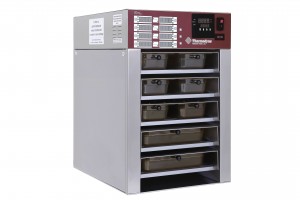Are countertop food warmers important? To a restaurant that needs to keep food at serving temperature long after it has been cooked, they are definitely an important part of that business. When using countertop food warmers, here are a few things you should keep in mind in order to obtain the maximum benefits from using them.
Cookers and warmers differ in their function, although some units can be used for both. Cookers are designed to take food from a frozen or refrigerated state to fully cooked, while warmers are intended to hold food at the right temperature for serving. If you are looking for precise temperature and or long term holding applications, the Thermodyne is the only choice. The patented Fluidshelf Technology allows the unit to run within 1F of the set temperature, the conduction style heating system also helps retain moisture in products so the end product will set you apart from the food next door. It’s important not to use a cooker to warm food, as it could cause it to scorch. Likewise, using a warmer to cook food will result in it being improperly prepared. Be sure to use the right equipment for the job so that your food can be greatly enjoyed by your customers. It should be noted, Thermodyne’s can be used for both applications.
Warmers can also be for either wet or dry use. When using a wet style warmer, steam from the water is essentially what keeps foot hot. As such, you should check water levels often, as allowing a wet model to run dry could also result in damage to the element. Thermodyne offers a wet and dry warmer option for their line of Hot Well units, these units can rethermalize, hold and serve from, very versatile.
Think about how often you will rotate your pans when purchasing a warmer. That way, you can be sure you have plenty of extra pans on hand whenever you need them. If you’re using less than standard sized pans, you could also need an adapter bar to hold them in place properly.
Drawer warmers are typically a better choice for self-serve breads, rolls and other pastries. These are dry warmers with relatively short cords on them, and may also have adjustable controls. Before placing food in these warmers, you should ensure that it is thoroughly cooked and already slightly warmer than the ideal serving temperature, as the constant opening of the drawer could cause the food to cool somewhat.
Kettles are preferred for serving soups, gravies, melted cheese and other sauces. These can normally be used to cook the food in prior to keeping it warm for serving. You have several choices available when it comes to lids, including solid, slotted and hinged lids. Hinged lids make it very easy for people to serve themselves, as customers would need to have somewhere to sit a traditional lid while they accessed the kettle.
Food warmers are versatile and easy to care for, making preparing and serving food safely a snap. Want to know more about food warmers? Contact us. Thanks.


